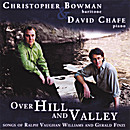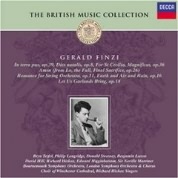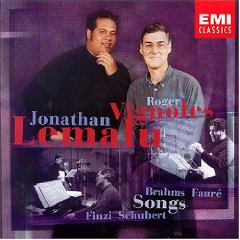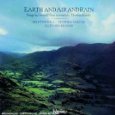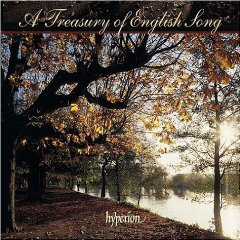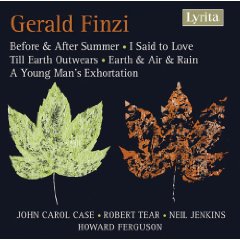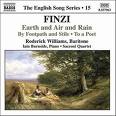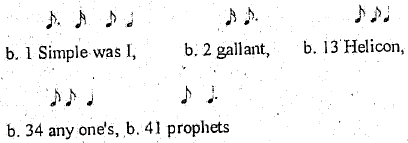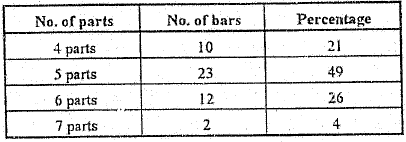So I Have Fared
Poet: Thomas Hardy
Date of poem: 187-
Publication date: 1922
Publisher:
Collection: Late Lyrics and Earlier
History of Poem:
Poem
After Reading Psalms XXXIX, XL, etc. |
||
|---|---|---|
Finzi's title: So I Have Fared |
||
| 1 | Simple was I and was young; | |
| 2 | Kept no gallant tryst, I; | |
| 3 | Even from good words held my tongue, | |
| 4 | Quoniam Tu fecisti! | |
| 5 | Through my youth I stirred me not, | |
| 6 | High adventure missed I, | |
| 7 | Left the shining shrines unsought; | |
| 8 | Yet - me deduxisti! | |
| 9 | At my start by Helicon | |
| 10 | Love-lore little wist I, | |
| 11 | Worldly less; but footed on; | |
| 12 | Why? Me suscepisti! | |
| 13 | When I failed at fervid rhymes, | |
| 14 | 'Shall,' I said, 'persist I?' | |
| 15 | 'Dies' (I would add at times) | |
| 16 | 'Meos posuisti!' | |
| 17 | So I have fared through many suns; | |
| 18 | Sadly little grist I | |
| 19 | Bring my mill, or any one's, | |
| 20 | Domine, Tu scisti! | |
| 21 | And at dead of night I call: | |
| 22 | 'Though to prophets list I, | |
| 23 | Which hath understood at all? | |
| 24 | Yea: Quem elegisti?' | |
(Hardy, 697-8) |
||
Content/Meaning of the Poem:
Speaker:
Setting:
Purpose:
Idea or theme:
Style:
Form:
Synthesis:
Published comments about the poem:
✦✼✦✼✦✼✦✼✦✼✦✼✦✼✦✼✦✼✦✼✦✼✦✼✦✼✦✼✦✼✦✼✦✼✦
✦✼✦✼✦✼✦✼✦✼✦✼✦✼✦✼✦✼✦✼✦✼✦✼✦✼✦✼✦✼✦✼✦✼✦
Musical Analysis
Composition date:
Publication date:
Publisher: Boosey & Hawkes - Distributed by Hal Leonard Corporation
Tonality:
Transposition:
Duration:
Meter:
Tempo:
Form:
Rhythm:
Melody:
Texture:
Vocal Range:
Tessitura:
Dynamic Range:
Accompaniment:
Published comments about the music:
Pedagogical Considerations for Voice Students and Instructors:
✦✼✦✼✦✼✦✼✦✼✦✼✦✼✦✼✦✼✦✼✦✼✦✼✦✼✦✼✦✼✦✼✦✼✦
✦✼✦✼✦✼✦✼✦✼✦✼✦✼✦✼✦✼✦✼✦✼✦✼✦✼✦✼✦✼✦✼✦✼✦
| Pitch Analysis | ||||||
|---|---|---|---|---|---|---|
| pitch | stanza 1 |
stanza 2 |
stanza 3 |
stanza 4 |
total | |
highest |
A |
|||||
G |
||||||
F |
||||||
E |
||||||
D |
||||||
middle C |
||||||
B |
||||||
A |
||||||
G |
||||||
F |
||||||
lowest |
E |
|||||
| Rhythm Duration Analysis of Vocal Line | |||||
|---|---|---|---|---|---|
| stanza 1 | stanza 2 | stanza 3 | stanza 4 | total | |
16th note |
|||||
8th note |
|||||
dotted 8th |
|||||
quarter note |
|||||
dotted quarter |
|||||
triplet |
|||||
half note |
|||||
dotted half |
|||||
stanza total |
|||||
✦✼✦✼✦✼✦✼✦✼✦✼✦✼✦✼✦✼✦✼✦✼✦✼✦✼✦✼✦✼✦✼✦✼✦
Audio Recordings
Over Hill and Valley: Songs of Ralph Vaughan Williams and Gerald Finzi |
|
|
|
The British Music Collection: Gerald Finzi |
|
|
|
Song Recital |
|
|
|
Songs: Brahms - Faure - Finzi - Schubert |
|
|
|
The Songs of Gerald Finzi to Words by Thomas Hardy
|
|
|
|
A Treasury of English Song |
|
|
|
Gerald Finzi |
|
|
|
The English Song Series - 15 |
|
|
|
✦✼✦✼✦✼✦✼✦✼✦✼✦✼✦✼✦✼✦✼✦✼✦✼✦✼✦✼✦✼✦✼✦✼✦
The following is an analysis of **** by Gerhardus Daniël Van der Watt. Dr. Van der Watt extended permission to post this excerpt from his dissertation on October 8th, 2010. His dissertation dated November 1996, is entitled:
The Songs of Gerald Finzi (1901-1956) To Poems by Thomas Hardy
This excerpt comes from Volume II and begins on page *** and concludes on page ***. To view the methodology used within Dr. Van der Watt's dissertation please refer to: Methodology - Van der Watt.
1. Poet
Specific background concerning poem:
"After Reading Psalms XXXIX, XL etc." is the second poem in Late Lyrics and Earlier first published in 1922. It is date 187- and thus was written at least forty years earlier than the date of publication. Together with the final poem "Surview" it contains a strong sense of self-examining and self-reproach, "a process that was proceeding in him [Hardy] all the time." (Seymour-Smith, 802)
2. Poem
After Reading Psalms XXXIX, XL, etc. |
||
|---|---|---|
| 1 | Simple was I and was young; | a |
| 2 | Kept no gallant tryst, I; | b |
| 3 | Even from good words held my tongue, | a |
| 4 | Quoniam Tu fecisti! | b |
| 5 | Through my youth I stirred me not, | c |
| 6 | High adventure missed I, | b |
| 7 | Left the shining shrines unsought; | c |
| 8 | Yet - me deduxisti! | b |
| 9 | At my start by Helicon | d |
| 10 | Love-lore little wist I, | b |
| 11 | Worldly less; but footed on; | d |
| 12 | Why? Me suscepisti! | b |
| 13 | When I failed at fervid rhymes, | e |
| 14 | 'Shall,' I said, 'persist I?' | b |
| 15 | 'Dies' (I would add at times) | e |
| 16 | 'Meos posuisti!' | b |
| 17 | So I have fared through many suns; | f |
| 18 | Sadly little grist I | b |
| 19 | Bring my mill, or any one's, | f |
| 20 | Domine, Tu scisti! | b |
| 21 | And at dead of night I call: | g |
| 22 | 'Though to prophets list I, | b |
| 23 | Which hath understood at all? | g |
| 24 | Yea: Quem elegisti?' | b |
(Hardy, 697-8) |
||
The persona of this poem, most certainly the poet, in introspective, self-criticising mood, contemplates his existence against the background of a number of Biblical psalms (39, 40 etc.). The psalmist (David) of psalm 39, has a firm resolve to be quiet initially but is unable to do so and asks God a number of direct questions concerning the brevity of his existence (verses 4-6). The psalm then follows a pattern of expressing hope in and rendering supplication from God and finally asking to experience joy before death. Psalms 40 and 41 follow the same pattern: an intimate conversation with the Creator that touches on praise, supplication and expressions of despair.
Against this backdrop, Hardy's poem is nothing but a nineteenth century psalm with Latin interjections. In stanza 1 the persona says that he lived a simple life: did little wrong or right and ends with "Quoniam Tu fecisti!" - Because/But You made me. The second stanza continues the idea of a n uneventful youth, not seeking the Creator, "Yet - me deduxisti!" - Yet You brought me down (onto my knees by implication). The reason for the mild contempt for worldly love and wisdom in Stanza 3, is "Me suscipisti!" - You have accepted me. In stanza 4 the persona doubts his own success at poetry and the answer comes from psalm 39 v. 5 "Dies Meos posuisti!" - You have made my days. The poet regrets (in stanza 5) that he has failed to produce anything much that is creative or of any lasting good but "Domine, Tu scisti!" - Lord, You know all. In the final stanza the persona, alone and isolated asks for understanding and enlightenment - "Quem elegisti?" - Whom did You choose? The implication at the end then, is that in spite of a struggle with the meaning of existence, the persona is left with the question of predestination.
The tone is contemplative, questioning and essentially satirical. It is also fairly consistent throughout with an intensification of the aforementioned atmosphere in the final stanza.
The style is that of a song or hymn and has also taken stylistic features from the psalms on which it is based, such as the conversational tone and actual Latin references.
The poem consists of 24 lines divided into six quatrains. Each quatrain has a simple scheme (abab) but the fact that the "I" sound caries through the entire poem at the end of every even line, has a unifying effect and is typical of Hardy's poetic discipline, especially in view of coordinating the Latin endings into the rhyme scheme.
The style and form of the poem carefully supports the text content. Even though this is an early poem, dating from the 1870s, the poet's characteristic economy of language, unflinching honesty and penetrating understanding of human existence, is evident. The poem is at heart an introspective yearning for the answer to the question: "Quem elegisti?". A different view of the poem could be that hardy, in re-discovering it after forty years, enjoys his own youthful exercise in feminine rhyming structures. Is Hardy making fun of himself? Was he short of material or pulling a joke on the public? Giving Hardy more credit, he may well have felt no closer to an answer to the question he posed with the psalmist forty years earlier and that struck him as wholly ironic.
Setting
1. Timbre
VOICE TYPE/RANGE
The song is set for baritone and the range is a perfect eleventh above the second A below middle C.
The piano accompaniment covers a range of roughly four octaves but the middle to lower range is favoured. In the final 12 bars both right hand and left hand parts are notated in the bass clef to enhance the intensification in the text and to support the reference to "...dead of night...". There are no indications of pedalling but the nature and movement of the chords of which the accompaniment mostly consists, would require sensitive and accurate legato pedalling. There are no indications of articulation other than that of legato playing from bar 27-37.
The almost stifled atmosphere created in the piano accompaniment through the use of subdued chords plays a less independent, more supportive role in the song. In this regard note should be taken of the stipulation by the composer at the bottom of the first page:
This recitative should be sung with the flexibility and freedom of ordinary speech, and the crotchet should approximate the reciting note of Anglican chant.
The atmosphere deepens just before bar 39 at the beginning of the final stanza. This is achieved by a lower piano timbre and deliberate retardation in tempo and harmonic rhythm. The composer wants the listener to take careful note of the meaning of the final stanza.
2. Duration
METRE
The text consists mainly of trochaic tetrameters (1, 2, 5, 6, 7, 8, 10, 11, 13, 15, 16, 18, 19, 21, 22). The musical metre varies considerably to accommodate the many stresses on the first syllable of the trochaic line, and to ensure a textual rhythm as close as possible to natural speech. The opening metre is 5/4 and deviations are listed below:
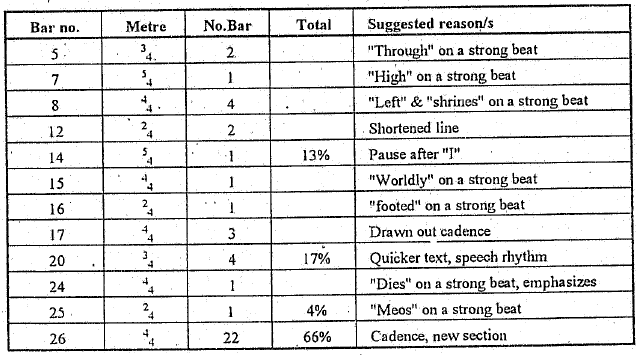
The most prominent metre is, therefore, common time, largely due to the more melodic arioso section starting in bar 27. All the deviations are functional: either to allow an important word to be stressed or to accommodate a phrase end.
Rhythmic motifs
Rhythmic motifs are less prominent in the song due to the extensive use of natural speech rhythms. There are, however, a number of rhythmic ideas that deserve mentioning. The most used motif in the vocal line is that of two quavers followed by two crotchets, usually at the phrase ends (b. 3, 6, 7, 10-11, 13, 14, 18-19, 25-26). (This motif will be carefully discussed under melodic material, since its melodic use is far more unifying.) The second rhythmic motif is that of a triplet followed by a variety of possibilities (b. 1, 3, 4, 24). Little rhythmic material establishes itself in the piano part. There are alternating crotchets and minims without establishing a noticeable pattern. This apparent lack of rhythmic coherence is in line with the indication, Quasi Recit. stromentato. For a brief moment between bars 27 and 32, a four note crotchet movement in the bass suggests a measured passing of time with the words. "So I have fared through many suns;"
Rhythmic activity vs. Rhythmic stagnation
While the piano accompaniment is mainly rhythmically stagnant, the melodic line provides the rhythmic movement. There is an even distribution of movement between piano and voice in bars 27-32 before the piano virtually comes to a single chord per bar halt, from bars 39-47.
Rhythmically perceptive, erroneous and interesting settings
The following words have been perceptively or interestingly dealt with rhythmically:
The only setting to be criticized is the lengthening of "Sadly" 9b. 31) which distorts the natural rhythm of the word.
Lengthening of voiced consonants
The following words containing voiced consonants have been rhythmically prolonged in order to make the word more singable:
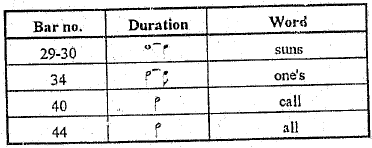
The tempo indication is Allegro, Quasi Recit stromentato ![]() Three deviations from the initial tempo occur after the double line in bar 26. These are listed below:
Three deviations from the initial tempo occur after the double line in bar 26. These are listed below:

The flexible tempo of the recitative section (b: 1-26) is made more metrical (A tempo giusto) to support the text meaning. The final slackening of tempo enhances the anti-climactic end and draws the listener's attention to the importance of the final question.
3. Pitch
An intervals analysis of the vocal line is represented in the following table:
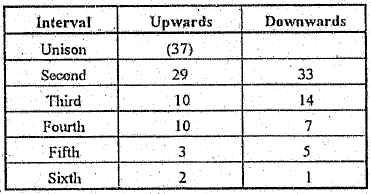
There are 37 repeated pitches (24%), 54 rising intervals (36%) and 60 falling intervals (40%). The marginally larger incidence of falling intervals and the relatively high occurrence of repeated pitches, tallies with the composer's intension to recall an Anglican chant in the song. This fact is further strengthened by the occurrence of 123 (81%) smaller intervals (repeated pitches, seconds and thirds) and only 28 (19%) larger intervals (fourths and larger). In this regard it should also be noted that there are no seventh or octave intervals. The following setting are significant:

In an almost chant-like context, these larger intervals are important moments of contrast and have been carefully placed to emphasize the significance of the text.
Melodic curve
A melodic curve of the vocal line is represented below. Certain words and phrases are indicated to show the relationship between the melodic curve and the meaning:
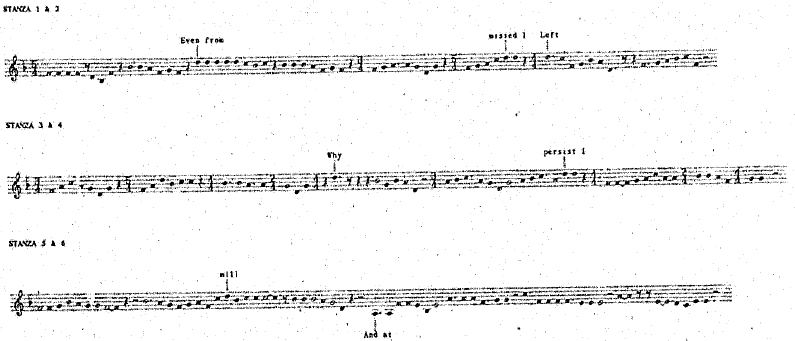
Melodic Motif
A melodic motif establishes itself quite firmly in the song and is then subtly varied in a number of places:

This extensive use of a melodic motif has a strong unifying effect in the song.
Climaxes
Vocal climaxes are given below:
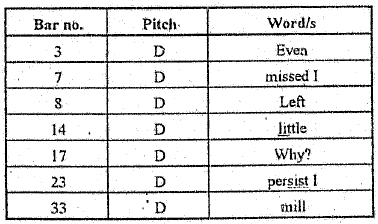
There is no real climax in the song but the D which is the highest note, does occur with important words and phrases. The lowest pitch (A: b. 39) occurs twice at the words "And at" which are not particularly significant other than that they are the first words of the final stanza in which an intensification of meaning takes place.
Phrase lengths
The phrase lengths are mainly one or two bars long and rests carefully follow the textual punctuation carefully. There are four longer phrases: Bars 20-23 (4 bars), 24-26 (3 bars), 27-30 (4 bars). Their length assist in the portrayal of the meaning.
The basic key is F major although the song ends in a minor. Modulations are reflected in the following table:

Chromaticism
The only true chromatic note is the C sharp in bar 37 (with bar 38 the only two bars of piano interlude) and it follows the text, "Domine, Tu scisti!" - Lord, You know all. This realization creates emotional discomfort and is highlighted by the use of a single chromatic note and the subsequent tonal shift to a minor.
HARMONY AND COUNTERPOINT
The harmonic rhythm is much slower than the textual rhythm and is in places static (b. 20-24, 39-47). There is a little more harmonic movement in the tempo giusto section (b. 27-32) where the unyielding passing of time is suggested.
Non-harmonic tones
Many suspensions are used (b. 6, 7, 8, 14, 15, 16, 26, 28, 29, 34, 36, 38, 46) to support the meaning of the text in the many hesitations and painful realization which accompany the process of self-examination.
Harmonic devices
A number of fourth-constructed chords appear in the treble clef (b. 4, 16, 25, 28, 31, 35). Though in most cases one of these notes is suspended, the fourth construction is still very audible due to the fact that the suspensions are hardly ever tied. The fourth-constructed chords coincide with important words (b. 35 "Domine,") and thus serve as a kind of sound or harmonic accent.
Counterpoint
Due to the recitative character of the song there is no use of contrapuntal devices.
Loudness variation is given in the following summary:

FREQUENCY
There are only 10 dynamic indications, meaning the 21% of the bars contain indications. These are concentrated in the last 21 bars. The implication is that the recitative section does not need extensive indications due to its reliance on the individual performer's interpretation of the flexible speech rhythm and emphasis. There are no separate indications for the voice but the indication colla voce (b. 1) in the piano part indicates Finzi's attitude towards the piano's loudness in relation to that of the voice: the piano should follow the voice and not dictate the dynamic level or the tempo.
RANGE
The highest indicated level is mf (b. 1 and 33) and the lowest pp (b. 39). The lowest level is of significance due to its occurrence at the start of the final, more intense stanza.
VARIETY
The indications used are:
DYNAMIC ACCENTS
The only portamento accent (but a very important one) occurs on the word "Which" (b. 43). This single use places strong emphasis on the penultimate question of the poem: "Which have understood at all? (1. 23).
The density varies loosely between four and seven parts including both voice and piano.
The thickness of the piano part is represented in the following table:
The five-part piano texture is present in almost half the song thus being the dominant texture. The one significant deviation occurs in bar 34 where a seven-part chord is used with the words, "any one's". This textural emphasis supports the ironic implication in the text that the poet has failed to do much of worth ("Sadly little grist I/Bring my mill, or any one's,").
The structure of the song can be represented as follows:

The song is only vaguely ternary, due to the more melodic section from bars 27-36. The different preceding stanzas (1-4) are treated vaguely strophically. The form of the song supports the meaning of the text.
7. Mood and atmosphere
A mood of quiet introspection is prevalent throughout the song with a slight intensification thereof in the last stanza. This is supported in the setting by the modulation to a minor key, static one chord per bar harmonic rhythm, the lowest dynamic level in the song, the use of a deeper piano register and the use of a slower tempo (Meno mosso b. 39).The only other significant aspect of atmospheric setting is in the piano material accompanying the second last stanza. "So I have fared through many suns," (incidently, this is the phrase from which Finzi has taken his title, from deeming the original After Reading Psalms XXXIX, XL etc., unsuitable). Here the unyielding trudge of time is suggested in the piano bass. The more arioso vocal style suggests a greater acceptance of the circumstances emanating from the text.
General comment on style
The sharp, somewhat ironic self-examination that is the subject matter of the poem, is appropriately set to music in the style of a recitative and short arioso, which reminds one of the recitative, arioso and aria styles used in Dies Natalis and Farewell to Arms. The harmonic language is tonal with slight explorations of dissonance in a number of fourth-constructed chords. The melodic material is handled sensitively with just enough cross-reference to create unity without exhausting any specific aspect.
Unpublished Analysis Excerpts
The following is an analysis of So I Have Fared by Curtis Alan Scheib. Dr. Scheib extended permission to post this excerpt from his dissertation on February 17th, 2012. His dissertation dated 1999, is entitled:
Gerald Finzi's Songs For Baritone On Texts By Thomas Hardy: An Historical And Literary Analysis And Its Effect On Their Interpretation
This excerpt begins on page forty-two and concludes on page forty-three.
After Reading Psalms XXXIX, XL, etc. |
||
|---|---|---|
Finzi's title: So I Have Fared |
||
| 1 | Simple was I and was young; | |
| 2 | Kept no gallant tryst, I; | |
| 3 | Even from good words held my tongue, | |
| 4 | Quoniam Tu fecisti! | |
| 5 | Through my youth I stirred me not, | |
| 6 | High adventure missed I, | |
| 7 | Left the shining shrines unsought; | |
| 8 | Yet - me deduxisti! | |
| 9 | At my start by Helicon | |
| 10 | Love-lore little wist I, | |
| 11 | Worldly less; but footed on; | |
| 12 | Why? Me suscepisti! | |
| 13 | When I failed at fervid rhymes, | |
| 14 | 'Shall,' I said, 'persist I?' | |
| 15 | 'Dies' (I would add at times) | |
| 16 | 'Meos posuisti!' | |
| 17 | So I have fared through many suns; | |
| 18 | Sadly little grist I | |
| 19 | Bring my mill, or any one's, | |
| 20 | Domine, Tu scisti! | |
| 21 | And at dead of night I call: | |
| 22 | 'Though to prophets list I, | |
| 23 | Which hath understood at all? | |
| 24 | Yea: Quem elegisti?' | |
(Hardy, 697-8) |
||
The poem, lamenting a life of non-achievement, is set here by Finzi in the form of an Anglican chant. The tempo marking at the beginning, Allegro, Quasi Recit stromentato, is followed by the explanation This recitative should be sung with the flexibility and freedom of ordinary speech, and the crotchet should approximate to the reciting note of Anglican chant. Finzi continues in this vein until the fifth verse of the poem, where he uses an arioso technique with an Elgarian marching bass to accompany "So I have fared through many suns. . . " The recitative returns at the end, the final "Quem elegist ?" ending with an austere open fifth in the piano.
The preceding was an analysis of So I Have Fared by Curtis Alan Scheib. Dr. Scheib extended permission to post this excerpt from his dissertation on February 17th, 2012. His dissertation dated 1999, is entitled:
Gerald Finzi's Songs For Baritone On Texts By Thomas Hardy: An Historical And Literary Analysis And Its Effect On Their Interpretation
The excerpt began on page forty-two and concluded on page forty-three.

